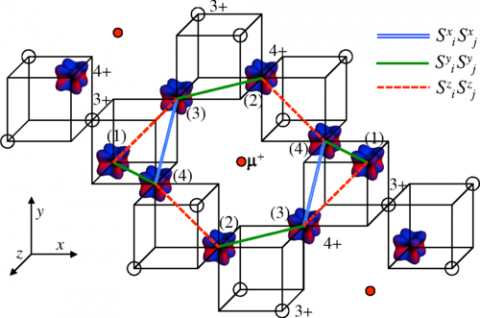
Using the μSR facilities at TRIUMF’s Centre for Molecular and Materials Science and J‑PARC, a team of researchers from KEK and the National Institute for Materials Science in Japan have discovered novel magnetism in an iridium compound, CuIr2S4. The result, published last month in Physical Review Letters, demonstrates that this compound, which was previously assumed to be non-magnetic, displays a highly-disordered magnetic state at low temperatures. The discovery in this research is the first experimental evidence concerning the importance of spin-orbit interactions which were previously overlooked in CuIr2S4. Given these properties, CuIr2S4 opens up a new area of research with respect to spin-orbit interactions in transition metals.
Muon spin rotation, relaxation and resonance (μSR) are particularly useful tools for examining materials with weak and disordered magnetism. The μSR technique uses positive muons, radioactive particles that live for only 2 millionths of a second, as probes inside the material. Researchers come to TRIUMF to use the intense muon beams and the associated μSR spectrometers to study their samples. The muon acts like a tiny bar magnet inside the sample. Information about the local magnetic field is transmitted to the experimenter when the muon decays into a positron, which is detected in the μSR spectrometer.
As CMMS research scientist Iain McKenzie explains, “Scientists use a range of analytical techniques to study materials; each provides a slightly different insight. This work highlights that μSR is very good for examining disordered magnetic behavior, which is incredibly difficult to study with other techniques, such as neutron scattering.”
The Japanese users who accomplished this result have close ties with TRIUMF, as longtime users of the CMMS facilities. In fact, the paper’s lead author, Kenji Kojima, has agreed to be the first Japanse member on the Molecular and Materials Science Experiment Evaluation Committee at TRIUMF, helping to steer further research directions.
The unique capabilities of μSR will be crucial as scientists continue to conduct fundamental research into magnetism. Stay tuned for more world-leading science from the CMMS beam lines!
For more information, read the paper here: http://journals.aps.org/prl/abstract/10.1103/PhysRevLett.112.087203
–Prepared by Lindsay Kroes, Communications Assistant and Iain McKenzie, CMMS Research Scientist
